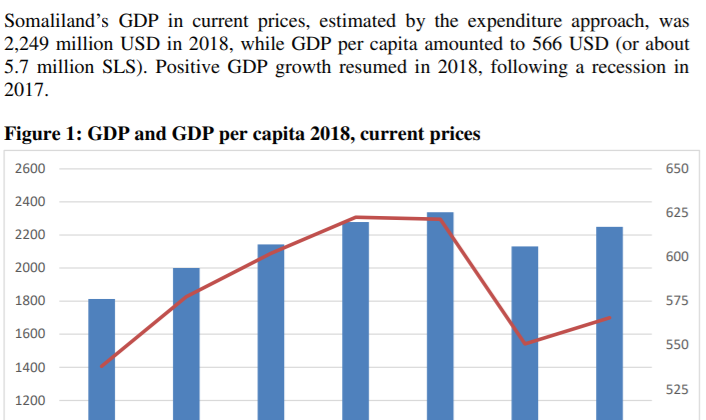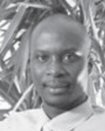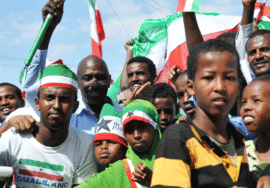
GDP 2012 in Somaliland
1 Introduction
The Minister of National Planning and Development has requested that the World Bank provide assistance in strengthening the ability to determine and monitor macroeconomic data. Accordingly, the World Bank Poverty Reduction and Economic Management (PREM) Somalia programme has hired a consultantto assist in developing estimates of GDP and to deal with related issues in economic statistics.Three missionshave been carried out, in January, April/May and September 2013.
The September mission concluded that the priority should be to get an estimate of the size of the economy. In practical terms this means an estimate of GDP by activity – the production approach – for 2012. As suggested in the report of September, the consultant has now prepared an estimate of GDP by activity for 2012. On the expenditure side, it has been possible to calculate final consumption expenditure by households and government. Indicative guesses have been added for gross fixed capital formation and exports; the intention is to give an approximate idea of the magnitude of imports. The results and the sources and methods are discussed in Section 2 of the report.
Two surveys were carried out in the first half of 2013 providing crucial data for calculating GDP for 2012.
- Theresults of the Somaliland Business Survey (SBS) were made available to the mission in September and analysed and prepared for use in the national accounts as described in Section 3 of the report.
- The data processing and analysis of the Somaliland Household Survey (SHS)were completed after the mission in September and were subsequently prepared and analysed by the consultant for use in the national accounts. This is described in Section 4 of the report.
2 GDP 2012
2.1 GDP by Activity
Appendix 1 presents the compilation of GDP by activity for 2012. It is a desk product and should be seen as preliminary; it could and should be modifiedafter scrutiny by stakeholders and emergence of additional evidence. It has, for example, not been possible to properly include activities funded by donor aid. About USD 60 million were disbursed in 2012 and could add 2-3% to the level of GDP.
Appendix 1 also provides GDP by activity converted into USD. The official exchange rate is used which certainly underestimates the numbers compared to a PPP-adjusted rate. Table 2.1 shows total GDP and per capita.
Table 2.1: GDP and GDP per capita
|
Product |
Values |
|
Total GDP, SLS billion |
8 991.0 |
|
GDP per capita, SLS thousand |
2 248 |
|
Total GDP, USD million |
1 390.9 |
|
GDP per capita, USD |
348 |
|
Exchange rate SLS/USD |
6 464 |
As discussed in Section 4 below there is no firm estimate of the total population, which is needed to raise the results of the SHS to national totals. The survey results have been raised assuming a population of 4 million. If the population instead is 3.5 million, total GDP would be about 5% lower.
The results and the sources and methods are described below, activity by activity. Because source data are scarce, evidence from other African countries – in particular Kenya – are used to estimate ratios such as intermediate consumption over output. The values are in billion SLS.
Growing of crops (ISIC A011)
|
Production account |
Values |
Sources |
|
Output |
921.9 |
Ministry of Agriculture for output of maize and sorghum Price data collected by the CBS; SHS for output of vegetables, fruits and other products(based on consumption) |
|
Intermediate consumption |
184.4 |
|
|
Gross value added |
737.5 |
|
|
Contribution to GDP |
8.2% |
The main crops in Somaliland are cereals with sorghum utilizing approximately 70% of the planted area and maize approximately 25%. Annual data on area planted and quantities harvested are provided by the Ministry of Agriculture. This is combined with price data collected by the CBS to calculate output;the prices are reduced with an estimated margin at 35% to derive producer prices.
Output of other products is estimated on the basis of consumption in SHS reduced by a margin at 35% and estimated import shares; a small addition is made for intermediate consumption in restaurants and exports.
Table 2.2: Output of crop farming
|
Product |
Marketoutput |
Own produce |
|
Cereals |
141.7 |
9.2 |
|
Grain mill products* |
|
15.9 |
|
Beans, peas, lentils |
32.2 |
|
|
Vegetables |
655.5 |
9.7 |
|
Fresh fruit |
64.4 |
1.1 |
|
Total |
921.9 |
35.9 |
* This is maize and sorghum flour processed on farm for own consumption
Intermediate consumption is estimated at 20% of output, based on Kenya’s national accounts.
The livestock industry (ISIC A014, C101& C105)
|
Production account |
Values |
Sources |
|
Output |
3 561.3 |
LMIS database for export numbers and prices Municipalities for slaughtered animals SHS for output of livestock products (meat for own consumption, milk, eggs, honey). |
|
Intermediate consumption |
910.8 |
|
|
Gross value added |
2 650.5 |
|
|
Contribution to GDP |
29.5% |
Animal production (ISIC A014), processing of meat (abattoirs, ISIC C101) and of milk (ISIC 105) constitute the livestock industry and are calculated and published together. Also the traders in livestock are included in the livestock industry although, properly classified, they are part of wholesale trade (ISIC G46).
The major part of the output of animals is exports, about 85% of sales of livestock in 2012. The data source is the LMIS database, which provides prices and number of animals exported. Other sources – the Berbera Port Authority and prices collected by the CSD – are normally very close to the LMIS data. Numbers of animals for slaughter are collected from the municipalities. Output of the abattoirs (mainly meat but also hides and skins) is estimated on the basis of the values of input of slaughtered animals; an addition of 30% is made to take account for other inputs and value added.
Output of other products is estimated on the basis of consumption in the SHS reduced by a margin at 35% and estimated import shares; a small addition is made for intermediate consumption in restaurants and exports. Output values are shown in the table overleaf; the table also shows the input ratios, which are based on Kenya’s national accounts.
Rearing of livestock constitutes production and changes in the numbers of animals – positive or negative – should be included in output as changes in inventories or gross fixed capital formation. However, there are no sources for estimating the changes in livestock herds.
Table 2.3: Output of the livestock industry
|
Product |
Market output |
Own produce |
|
Animals for exports and slaughter |
2 981.8 |
|
|
Meat and meat products* |
579.5 |
8.6 |
|
Milk |
312.7 |
42.1 |
|
Eggs, honey and other products |
11.5 |
0.1 |
|
Total |
921.9 |
35.9 |
* Market output also includes hides and skins
Forestry (ISIC A03)
|
Production account |
Values |
Sources |
|
Output |
609.7 |
SBS: ratios in the production of resins SHS: output of charcoal and firewood based on consumption Impact of Charcoal Production on Environment and the Socio Economy of Pastoral communities of Somaliland (case study 2004). |
|
Intermediate consumption |
145.7 |
|
|
Gross value added |
464.0 |
|
|
Contribution to GDP |
5.2% |
Only four enterprises in the resins industry were included in the SBS, so the results are far below compared to what is produced by the resins industry. A tentative guesstimate is made for output, 200 billion SLS.The ratio of intermediate consumption is taken from the SBS.
In addition to resins, forestry includes charcoal, firewood as well as wood poles and thatching grass for construction; firewood is also collected for own consumption. The output estimates are based on the SHS: purchases of charcoal and firewood were recorded as well as the value of collected firewood.Ratios of intermediate consumption over output are based on the national accounts of Kenya and Uganda.
Table 2.4: Output of forestry
|
Product |
Market output |
Own produce |
|
Charcoal |
382.6 |
|
|
Firewood |
20.9 |
20.9 |
|
Wood poles and thatching grass |
1.3 |
|
|
Resins |
200.0 |
|
|
Total |
588.8 |
20.9 |
Fishing (ISIC A03)
|
Production account |
Values |
Sources |
|
Output |
17.8 |
SBS: ratios in the production account SHS:total output (based on consumption) |
|
Intermediate consumption |
2.7 |
|
|
Gross value added |
15.2 |
|
|
Contribution to GDP |
0.2% |
The estimates are based on the results of the two surveys; output and intermediate consumption according to the SBS are raised with output calculated on the basis of household consumption in the SHS plus estimated exports.
Mining (ISIC B)
|
Production account |
Values |
Sources |
|
Output |
134.4 |
SBS |
|
Intermediate consumption |
13.4 |
|
|
Gross value added |
121.0 |
|
|
Contribution to GDP |
1.3% |
The SBS included 18 enterprises of which five reported extraction of metal ores. None of the respondents reported quarrying of stone and sand, although that certainly exists. Stone and sand are important inputs in construction and are estimated on the basis of imports of cement; there is a ratio of sand and aggregates to the use of cement.
Manufacturing excl. livestock products (ISIC C excl. C101 & C105))
|
Production account |
Food & drinks |
Other |
Total |
Sources |
|
Output |
403.3 |
221.0 |
624.2 |
SBS SHS State Print Agency |
|
Intermediate consumption |
285.3 |
167.3 |
452.6 |
|
|
Gross value added |
118.0 |
53.7 |
171.6 |
|
|
Contribution to GDP |
1.3% |
0.5% |
1.9% |
Separate estimates are made for Manufacture of food and beverages and Other manufacturing. The details are shown in Table 2.5 overleaf.
Output of sorghum/maize flour is derived by deducting consumption of cereals from output of cereals; this is assumed to be processed in mills. An addition is made for other inputs (5%) and value added (25%). Milling fees is derived from the SHS; intermediate consumption is assumed at 15%. Output of bread is derived from consumption of bread in the SHS. Intermediate consumption is estimated at 80% as in
Kenya’s national accounts; the ratio according to the SBS is not realistic at less than 50%.
Table 2.5a: Table 2.5b:
Output of food and beverages Output of other products
|
Product |
Values |
|
Product |
Values |
|
Sorghum/maize flour |
123.8 |
|
Soaps and detergents |
51.8 |
|
Milling fees |
35.8 |
|
Metal products / work |
56.8 |
|
Bread |
181.3 |
|
Furniture |
21.2 |
|
Other food products |
1.7 |
|
Other products |
49.0 |
|
Beverages |
60.6 |
|
Addition based on SHS |
40.0 |
|
|
|
|
State Print Agency |
2.2 |
|
Total |
403.3 |
|
Total |
221.0 |
Other food products and beveragesare as estimated in the SBS, both output and intermediate consumption. Coca Cola recently established a plant in Somaliland which should have been included in the SBS but this needsbe checked; if not manufacture of beverages is underestimated.
The production accounts for other manufacturing are as recorded in the SBS with a tentative addition based on the enterprise module in the SHS. The income statement of the State Printing Agency is also included in the estimates.
Electricity supply (ISIC D)
|
Production account |
Values |
Sources |
|
Output |
446.7 |
Data from two electricity suppliers SBS: expenditure on electricity& one respondent SHS: household consumption of electricity |
|
Intermediate consumption |
371.8 |
|
|
Gross value added |
74.9 |
|
|
/Contribution to GDP |
0.8% |
Detailed data are available from two electricity suppliers, Somaliland Electricity Agency and Borama Power Station, as well asthe response by one respondent to the SBS; this is covering only a fraction of all electricity suppliers.Output is set equal to the expenditure on electricity according to the SBS plus household consumption expenditure derived from the SHS. The income statements of SEA report huge losses, which have tentatively been treated as subsidies.
Water supply; sewerage; waste management (ISIC E)
|
Production account |
Values |
Sources |
|
Output |
45.8 |
Income statements from two municipalities and total water revenue from the rest |
|
Intermediate consumption |
31.5 |
|
|
Gross value added |
14.3 |
|
|
Contribution to GDP |
0.8% |
The estimates are based on detailed income statements from two municipalities and total revenue for the rest of them, assuming the same ratios. The SBS included two enterprises in waste management but they didn’t provide any economic data except employment.
The SHS only recorded household expenditure on sewerage and not on water; sewerage is assumed to be included in the revenue of the water agencies. Besides, there are two other categories of water output consumed by households that are not included in the estimate:
- Water may be sold privately, e.g. by owners of berkads and boreholes.
- Water is collected by households for own consumption.
Construction (ISIC F)
|
Production account |
Values |
Sources |
|
Output |
716.0 |
SBS SHS: household purchases of building materials |
|
Intermediate consumption |
382.3 |
|
|
Gross value added |
333.7 |
|
|
Contribution to GDP |
3.7% |
The SBS included 43 enterprises(representing 148) of which 39 (representing 131) were active in construction of buildings and the remaining ones in civil engineering projects accounting for 80% and 20% of output respectively. The survey is taken to cover the formal construction enterprises. An addition is made for own construction by households based on household purchases of building materials.
Wholesale and retail trade; repair of motor vehicles (ISIC G)
|
Production account |
Values |
Sources |
|
Output |
3 083.2 |
SBS SHS for margins on household consumption |
|
Intermediate consumption |
1 325.8 |
|
|
Gross value added |
1 757.4 |
|
|
Contribution to GDP |
19.6% |
The trade industry (ISIC G) also includes repair and maintenance of motor vehicles. The SBS included187 enterprises (representing 1938). As indicated in Section 3 below, it was only possible to use the data on sales, labour cost and employment. Thus it was not possible to use the data on expenses as recorded by the survey and, therefore, ratios for intermediate consumption and trade margins from other countries in the region were used. Output of trade services is defined as the margin, i.e. as the difference between sales and purchases of goods for resale.Output according to the survey is: repair services = 59.6; and trade margins = 1023.1.
The SBS is certainly underestimating trade services. Therefore, a total has been estimated on the basis of household consumption of goods (35% for most goods) and an estimated 10% of intermediate consumption of goods by all producers; the latter is of course a very rough estimate.
Transport and storage (ISIC H)
|
Production account |
Values |
Sources |
|
Output |
323.9 |
Berbera Port Authority SHS for output of public transport |
|
Intermediate consumption |
185.5 |
|
|
Gross value added |
138.4 |
|
|
Contribution to GDP |
1.5% |
The SBS included only three enterprises, so the results are not useful.The income statement from Berbera Port Authority provides data for port activities.Output of passenger transport is estimated on the basis of the SHS; expenditure is recorded for three categories: bicycle taxi, bus/minibus, and other (ox cart, truck). Output of freight services is a pure guess at 200 billion SLS. Intermediate consumption is estimated with ratios from Kenya’s national accounts.
Accommodation and food service activities (ISIC I)
|
Production account |
Values |
Sources |
|
Output |
548.9 |
SBS SHS output of small scale operators (consumption of prepared food |
|
Intermediate consumption |
289.9 |
|
|
Gross value added |
259.0 |
|
|
Contribution to GDP |
2.9% |
The SBS included 47 enterprises (representing 292) of which 11 (62) are hotels and 36 (230) restaurants and the like. Their shares of the estimated value added are 56% and 44% respectively. In particular restaurants are underestimated by the SBS as there are many small scale operators selling cooked food from stalls. An estimate of these is derived from the SHS as the household expenditure on prepared food and is added to the restaurant output according to the SBS. Besides, the output of hotels in the survey has been increased by 10%. Ratios of intermediate consumption over output are derived from the SBS.
Information and communication (ISIC J)
|
Production account |
Values |
Sources |
|
Output |
312.3 |
SBS |
|
Intermediate consumption |
110.7 |
|
|
Gross value added |
201.6 |
|
|
Contribution to GDP |
2.2% |
The SBS included 36 enterprises that comprise newspaper publishers (2), radio and TV (4), telecommunications (28) and computer consultancies (2). The two largest respondents in terms of employment – which may be Telesom and Somtel did not provide economic data and, therefore, were estimated on the basis of employment as described in Section 3. It would be important to check whether these respondents are indeed Telesom and Somtel and try to obtain their income statements for 2012.
Financial activities (ISIC K)
|
Production account |
Values |
Sources |
|
Output |
69.8 |
SBS Bank of Somaliland, income statement |
|
Intermediate consumption |
40.5 |
|
|
Gross value added |
29.3 |
|
|
Contribution to GDP |
0.3% |
There are two components making up the numbers: the Bank of Somaliland based (its income statement) and the results of the SBS. There are 21 respondents to the survey. Nine of these did not provide data on their sales, which were then estimated on the basis of employment. Dahabshil was included in the survey. The total sales according to SBS were 54,329 million SLS. With a commission of 3% of the 20% that goes to the local agent, this would indicate total remittances of 1.4 million USD in 2012.
Real estate activities (ISIC L)
|
Production account |
Values |
Sources |
|
Output |
609.6 |
SBS: rental expenses SHS: number of dwellings & rental income |
|
Intermediate consumption |
38.0 |
|
|
Gross value added |
571.6 |
|
|
Contribution to GDP |
6.4% |
The classification of the five enterprises included in the SBS should be checked as it could be construction rather than real estate; the results based of the survey are not used for the estimate of GDP. On the other hand, the total expenditure on rent as calculated in the survey is used to estimate rentals of non-residential premises together with rental income for shops and stores as recorded in the SHS. The non-residential rentals are then estimated at 75 billion SLS; the ratio of intermediate consumption is set at 15%.
The estimate of dwelling rentals is based on the number of households by category of household and type of dwellings as shown in Table 2.6 below.
Table 2.6: Dwelling rentals
|
|
Rent (year) |
Monthly rent |
Number of households |
|||
|
Type of household / dwelling |
Rented |
Own |
Rented |
Own |
Rented |
Own |
|
House, rural |
6.8 |
48.7 |
118 |
118 |
4 804 |
34 356 |
|
House, urban |
223.9 |
205.1 |
357 |
179 |
52 196 |
95 625 |
|
Other types, rural |
1.3 |
12.6 |
30 |
30 |
3 684 |
35 492 |
|
Other types, urban |
2.9 |
10.0 |
30 |
30 |
8 181 |
28 206 |
|
Displaced |
|
0.5 |
6 |
|
15 573 |
|
|
Nomadic |
|
12.0 |
6 |
|
343 750 |
|
|
Total |
234.9 |
288.9 |
|
|
68 865 |
553 001 |
The monthly rentals for houses are based on rental income as recorded in the SHS; the averages for urban houses are, however, scaled down as they appear very high. Other types of houses – tents, dormitories and others – are estimated at a quarter of rural rentals while displaced and nomadic households have been assigned anominal monthly rental of about 6 000 SLS.
Professional and support services (ISIC MN)
|
Production account |
Values |
Sources |
|
Output |
185.0 |
SBS: expenses for machinery rental SHS: income from car and machinery rentals |
|
Intermediate consumption |
42.5 |
|
|
Gross value added |
142.5 |
|
|
Contribution to GDP |
1.6% |
There were only two respondents in the SBS stating their activity as advertising of renting of machinery respectively; not useful. On the other hand, the SBS provides data on expenditure of machinery rentals, in total 21.5 billion SLS. Besides, the SHS provides data on income from car rentals. Combining these two sources, total rentals are estimated at 75 billion. Output of other types of services is a guess:
- 50 billion SLS for enterprises providing professional services such as accounting, auditing and engineering.
- 70 billion SLS for support services such as security, travel agencies and cleaning activities.
Public administration and defence (ISIC O)
|
Production account |
Central |
Local |
Total |
Sources |
|
Output |
390.0 |
49.7 |
439.7 |
Ministry of Finance Somaliland Road Authority Income statement from the municipalities |
|
Intermediate consumption |
105.0 |
33.2 |
138.2 |
|
|
Gross value added |
285.0 |
16.5 |
301.5 |
|
|
Contribution to GDP |
3.2% |
0.2% |
3.4% |
Central government excluding education and health has been defined as public administration and, likewise, all activities of the municipalities. This may not be entirely correct as especially the municipalities are engaged in activities that should not be classified in public administration. Central government also includes the Somaliland Road Authority. Output of government is defined as the sum of costs: intermediate consumption, compensation of employees and consumption of fixed capital. There is no data on the latter – a theoretically computed variable – so an approximate estimate has been inserted at 5% of staff costs.
Education (ISIC P)
|
Production account |
Private |
Public |
Total |
Sources |
|
Output |
300.4 |
45.9 |
346.3 |
Ministry of Finance SHS |
|
Intermediate consumption |
105.1 |
2.6 |
107.7 |
|
|
Gross value added |
195.3 |
43.3 |
238.6 |
|
|
Contribution to GDP |
2.2% |
0.5% |
2.7% |
Public education is calculated as recorded under government expenditure; these include teachers’ salaries. Output is calculated as described for Public administration above. Private education is estimated on the basis of household expenses on education; 65% of this is assumed to be payment for services such as tuition fees. Intermediate consumption is estimated at 65% of output. Both ratios are derived from Kenya’ national accounts.
The government accounts do not record any income under education. Fees paid to public schools are therefore included under private education. It is then assumed that expenses funded by the fees are not recorded under government expenditure.
Health and social work (ISIC Q)
|
Production account |
Private |
Public |
Total |
Sources |
|
Output |
175.5 |
18.5 |
194.0 |
Ministry of Finance SHS |
|
Intermediate consumption |
61.4 |
4.3 |
65.7 |
|
|
Gross value added |
114.1 |
14.2 |
128.3 |
|
|
Contribution to GDP |
1.2% |
0.2% |
1.4% |
Health is estimated in the same way as described for education. The ratio of services in the household expenditure on health is set at 60% and the ratio of intermediate consumption over output at 35%
Other services (ISIC RST)
|
Production account |
Values |
Sources |
|
Output |
46.3 |
SBS: hairdressers and ratio of intermediate consumption SHS: various services |
|
Intermediate consumption |
9.3 |
|
|
Gross value added |
37.0 |
|
|
Contribution to GDP |
0.4% |
There were six respondents in the SBS representing 87 enterprises; the majority of these were hairdressers. The SHS did not record any expenditure on hairdressing, so output of such services is based on the SBS. Output of other services is based on the SHS. These include recreation, battery charges; laundry and wages to domestic servants.
Finally, the SHS recorded 69.5 billion SLS as expenditure on funerals, weddings and other celebrations. It is assumed that 25% of this is payment for services while the rest should be expenditure on various goods, e.g. catering.
Taxes and subsidies on products
Taxes on products are mainly levied on imports with 12 different levies that vary–one way or the other – with the amount of imports. They include:
|
Import duty |
Livestock levy |
Fuel levy |
|
Export duty |
Administration tax |
Development tax |
|
Harbour tax |
Permit fee |
KDH |
|
Sales tax |
Stamp duty |
Municipality tax |
The revenue of the municipalities include an item “commodities tax” that appears to be a product tax. One product subsidy has been recorded as indicated under Electricity above; could be questionable.
2.2 GDP by Expenditure
The estimates in Table 2.7 are an illustration and must be used as such. The intention is to give an idea of a possible imports total compared to what is recorded by the Customs Department.
Table 2.7: GDP by expenditure
|
Description |
SLS billion |
% share |
|
Final consumption expenditure by households |
10 349.8 |
115.1 |
|
Final consumption expenditure by government |
504.1 |
5.6 |
|
Gross fixed capital formation |
900.0 |
10.0 |
|
Exports of goods and services |
2 500.0 |
27.8 |
|
Minus: Imports of goods and services |
5 498.5 |
58.5 |
|
GDP at market prices |
8 991.0 |
100.0 |
Only the two consumption items are based on comprehensive data. The numbers are estimated as follows:
- Household consumption is calculated on the basis of the SHS-results. Details are provided in Table 2.8 below followed by a few comments.
- Government consumption is equal to total output of public administration plus output of government education and health. It may be slightly overestimated as revenue from sales and fees should be deducted; it has not been possible to identify such items.
- Gross fixed capital formation. The major part – say 95% or 680 billion – of construction output is GFCF. A tentative addition is made for machinery and transport equipment.
- Exports of livestock constitute the major part of exports, 2 165 million in 2012. The “rounding-up” to 2 500 is a guess.
- Imports are derived as a residual. The total recorded by Customs is 1 631.4 billion or 30% of the imports in Table 2.7, which also includes services.
Table 2.8: Final consumption expenditure by households
|
Main categories |
Acquisitions |
Own produce |
Total |
Per cent |
|
Food and beverages |
6 001.0 |
134.7 |
6 135.7 |
59.3% |
|
Qat & cigarettes |
515.9 |
515.9 |
5.0% |
|
|
Clothing and footwear |
440.1 |
440.1 |
4.3% |
|
|
Housing |
1 319.5 |
320.6 |
1 640.1 |
15.8% |
|
Other goods (mainly durable) |
88.3 |
88.3 |
0.9% |
|
|
Education expenses |
775.2 |
775.2 |
7.5% |
|
|
Health care expenses |
462.1 |
462.1 |
4.5% |
|
|
Services n.e.s. |
292.5 |
292.5 |
2.8% |
|
|
Total |
9 894.5 |
455.3 |
10 349.8 |
100.0% |
With a few exceptions, the numbers in Table 2.8 are derived from expenditure data in the SHS; Section 4 below explains how the survey data have been raised and prepared for use in the national accounts. The exceptions – where other sources are used – are:
- The recorded imports including duties of qat and cigarettes are far above the expenditure according to the SHS; this kind of expenditure is normally underreported in household surveys.
- The SHS did not include any question on rental expenditure, which is calculated as described above.
- Expenditure on hairdressing was not included in the SHS and has been estimated on the basis of output derived from the SBS.
3 The Business Survey
The SBS included a sample of 504 enterprises of list of close to 3,100 enterprises. It included sections on employment, sales and costs – data that are useful for the GDP-estimates. The economic activities of the respondents were classified according to ISIC, rev.4 and according to legal status (share-holding company, sole proprietorship, partnership and limited partnership). Although virtually all respondents provided data on employment, many refused or were unable to provide data on sales and costs. Table 3.1 shows summary data on the respondents.
The table gives an indication of the non-response to the economic questions – it was quite high. The mission made imputations for missing data. They were based on assumptions of similarity between enterprises in the same industry as defined by the 4-digit ISIC-code. The results after these imputations are shown in Table 3.2. In brief the methods were as follows:
Table 3.1: Summary of the Somaliland Business Survey
|
Description |
Number |
Per cent |
|
Number of enterprises |
503 |
|
|
Corporations[1] |
198 |
39.4 |
|
Household enterprises[2] |
305 |
60.6 |
|
Did not provide data on labour cost |
63 |
12.5 |
|
Did not provide data on sales |
98 |
19.4 |
- The full time equivalent employment was calculated by dividing the number of part time employees by two and multiplying the number of temporary employees by months worked divided by 12.
- Missing data on labour costs were imputed by assuming the same average salary as for responding enterprises.
- Missing data on other costs (not labour) were imputed by assuming the same ratio to sales as for responding enterprises.
- It was not possible to use that method for other costs regarding wholesale and retail trade. Ratios from other African countries were used to estimate trade margins and intermediate consumption.
- A number of ad hoc adjustments were made where responses looked impossible.
Table 3.2: Results of the SBS as prepared for the GDP-estimates
|
Description |
Output |
Interm consum |
Value added |
Comp of employ |
Employ-ment |
|
Growing of crops |
8.7 |
3.6 |
5.1 |
2.2 |
201 |
|
Livestock industry |
23.8 |
10.8 |
13.1 |
4.6 |
448 |
|
Forestry |
4.7 |
2.3 |
2.4 |
0.9 |
175 |
|
Fishing |
15.8 |
5.57 |
10.24 |
2.60 |
565 |
|
Mining and quarrying |
119.4 |
11.91 |
107.50 |
2.05 |
471 |
|
Manufacture of food excl meat processing |
78.9 |
43.87 |
34.98 |
9.83 |
652 |
|
Manufacturing excl food and beverages |
156.8 |
122.87 |
33.95 |
62.41 |
4 697 |
|
Electricity supply |
7.8 |
6.5 |
1.3 |
1.1 |
0 |
|
Water supply; sewerage |
|||||
|
Construction |
683.4 |
360.5 |
322.8 |
66.57 |
18 877 |
|
Wholesale & retail trade; repair of vehicles |
1 044.0 |
448.9 |
595.1 |
140.18 |
14 167 |
|
Transportation and storage |
6.0 |
5.1 |
0.9 |
0.9 |
92 |
|
Accommodation and food service activities |
215.9 |
109.2 |
106.7 |
45.5 |
4 283 |
|
Information and communication |
312.3 |
110.7 |
201.6 |
59.9 |
6 509 |
|
Financial and insurance activities |
54.3 |
37.2 |
17.2 |
3.7 |
336 |
|
Real estate activities |
28.2 |
24.0 |
4.2 |
8.2 |
497 |
|
Professional and support services |
17.1 |
8.8 |
8.3 |
3.8 |
321 |
|
Other service activities |
4.9 |
1.1 |
3.8 |
0.9 |
505 |
|
Total |
2 782.1 |
1 313.0 |
1 469.1 |
415.4 |
52 795 |
4 The Somaliland Household Survey
The weights used in SHS dataset could not be constructed on the basis of the population of Somaliland and its distribution; there were no reliable population data. Analytical weights were constructed for the survey allowing the derivation of representative statistics for rural and urban areas. Moreover, the survey was designed to cover settlements which exclude nomadic and displaced households although a few displaced (26) and nomadic (4) households were included. Notwithstanding, the design of the sample, national totals are needed for the estimates of GDP. Scaling factors were therefor calculated to adjust the weights based on available estimates of the population.
Somaliland in Figures (SIF) 2011 cites a population of 4.1 million in 2011; this is derived by an estimated annual population growth at 3.14% since2006, when the UNDP estimated the population at 3.5 million with two thirds as rural or nomadic, while SIF cites 55% as nomadic and 45% as resident rural or urban. The displaced population is urban and amounts to about 85 000 according to a study in 2012[1]. The scaling of weights has been calculated as shown in Table 4.1; the population is set at 4 million.
Table 4.1: Population and scaling factors
|
|
Raised survey numbers |
Country totals |
Totals / Survey |
||||
|
Description |
Households |
Population |
Households |
Population |
Per cent |
Scaling1 |
Scaling2 |
|
Resident, rural |
64 451 |
394 582 |
78 404 |
480 000 |
12% |
1.22 |
6.77 |
|
Resident, urban |
71 196 |
477 090 |
184 298 |
1 235 000 |
31% |
2.59 |
2.59 |
|
Displaced |
1 685 |
9 197 |
15 573 |
85 000 |
2% |
9.24 |
9.24 |
|
Nomadic |
241 |
1 544 |
343 750 |
2 200 000 |
55% |
1 425.13 |
6.77 |
|
Total |
137 573 |
882 412 |
622 024 |
4 000 000 |
100% |
4.53 |
4.53 |
The four nomadic households in the survey are certainly not a statistically representative sample. Nevertheless, the expenditure pattern of nomadic households may differ from resident households and, therefore, separate scaling factors are calculated for resident rural and nomadic households (Scaling1). Scaling2 pools all rural households and is used to scale the weights for food and charcoal, while Scaling1 is used for all other expenditure items.
The survey data are raised to annual totals by multiplying weekly expenditure by 52, monthly by 12 and three-monthly by 4. A number of modifications have been made to the survey results.
- Unlikely values have been edited often by changing the unit from/to K (thousand SLS) and S (hundred SLS).
- Missing values have been calculated by applying the average of the responses with values.
- There are no values for many own producedfood items, only quantities. Values have then been calculated using the average unit price as derived from other responses.
Appendix 1 GDP by Activity 2012
|
Description |
Output |
Interm consum |
Value added |
Contri–bution |
USD million |
|
Growing of crops |
921.9 |
184.4 |
737.5 |
8.2% |
114.1 |
|
Livestock industry |
3 561.3 |
910.8 |
2 650.5 |
29.5% |
410.0 |
|
Forestry |
609.7 |
145.7 |
464.0 |
5.2% |
71.8 |
|
Fishing |
17.8 |
2.7 |
15.2 |
0.2% |
2.3 |
|
Mining and quarrying |
134.4 |
13.4 |
121.0 |
1.3% |
18.7 |
|
Manufacturing excl meat processing |
624.2 |
452.6 |
171.6 |
1.9% |
26.6 |
|
Electricity supply |
446.7 |
371.8 |
74.9 |
0.8% |
11.6 |
|
Water supply; sewerage; waste management |
45.8 |
31.5 |
14.3 |
0.2% |
2.2 |
|
Construction |
716.0 |
382.3 |
333.7 |
3.7% |
51.6 |
|
Wholesale & retail trade; repair of motor vehicles |
3 083.2 |
1 325.8 |
1 757.4 |
19.5% |
271.9 |
|
Transportation and storage |
323.9 |
185.5 |
138.4 |
1.5% |
21.4 |
|
Accommodation and food service activities |
548.9 |
289.9 |
259.0 |
2.9% |
40.1 |
|
Information and communication |
312.3 |
110.7 |
201.6 |
2.2% |
31.2 |
|
Financial and activities |
69.8 |
40.5 |
29.3 |
0.3% |
4.5 |
|
Real estate activities |
609.6 |
38.0 |
571.6 |
6.4% |
88.4 |
|
Professional and support services |
185.0 |
42.5 |
142.5 |
1.6% |
22.0 |
|
Public administration and defence |
439.7 |
138.2 |
301.5 |
3.4% |
46.6 |
|
Education |
346.3 |
107.7 |
238.6 |
2.7% |
36.9 |
|
Human health and social work activities |
194.0 |
65.7 |
128.3 |
1.4% |
19.8 |
|
Other service activities |
50.8 |
11.0 |
39.8 |
0.4% |
6.2 |
|
Sum of values added at basic prices |
13 241.6 |
4 850.7 |
8 390.9 |
93.3% |
1 298.1 |
|
Taxes and subsidies on products |
600.2 |
6.7% |
92.8 |
||
|
GDP at purchasers’ prices |
8 991.0 |
100.0% |
1 390.9 |
||
|
GDP per capita, SLS thousand / USD |
|
|
2 248 |
|
348 |










